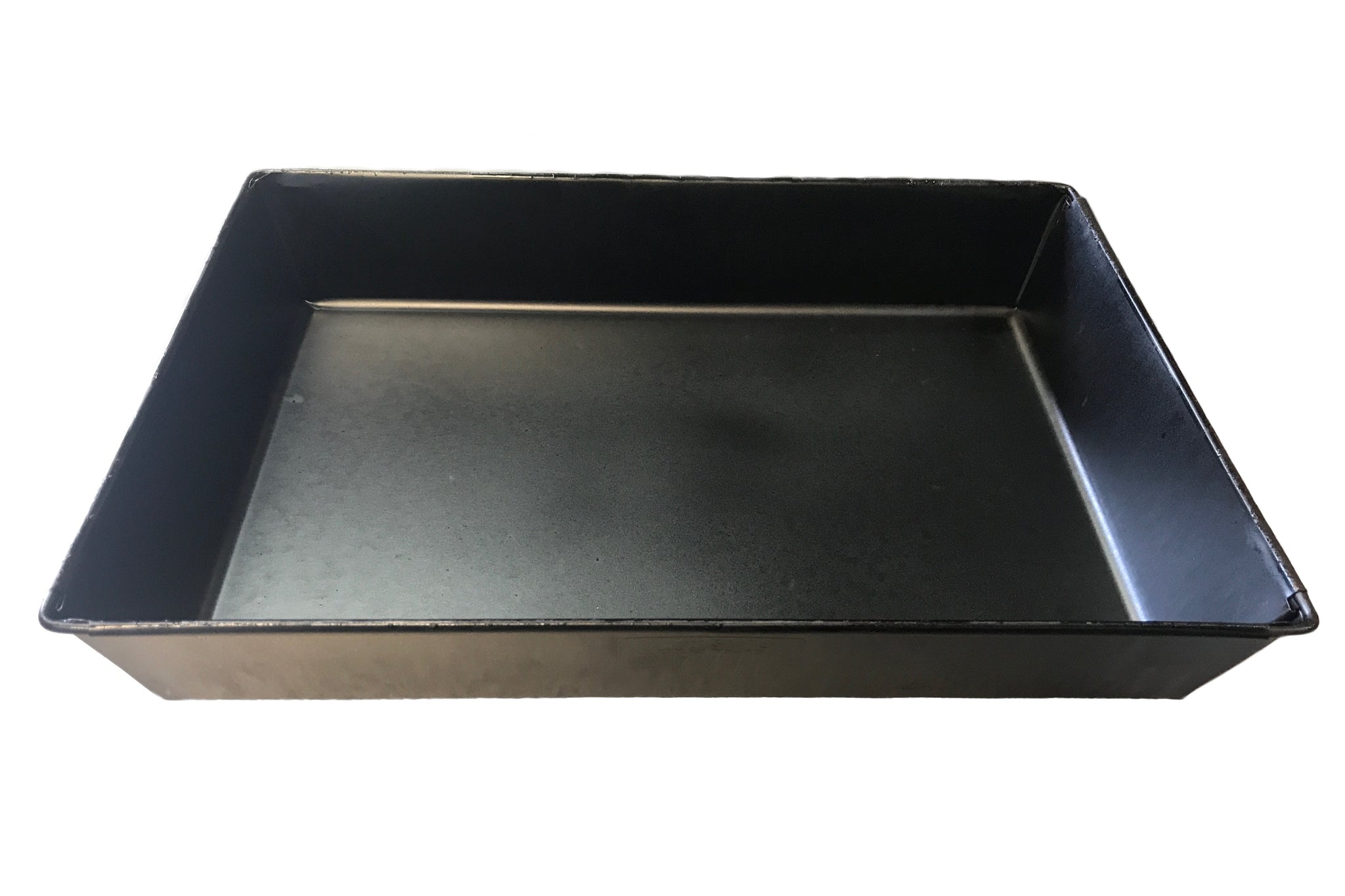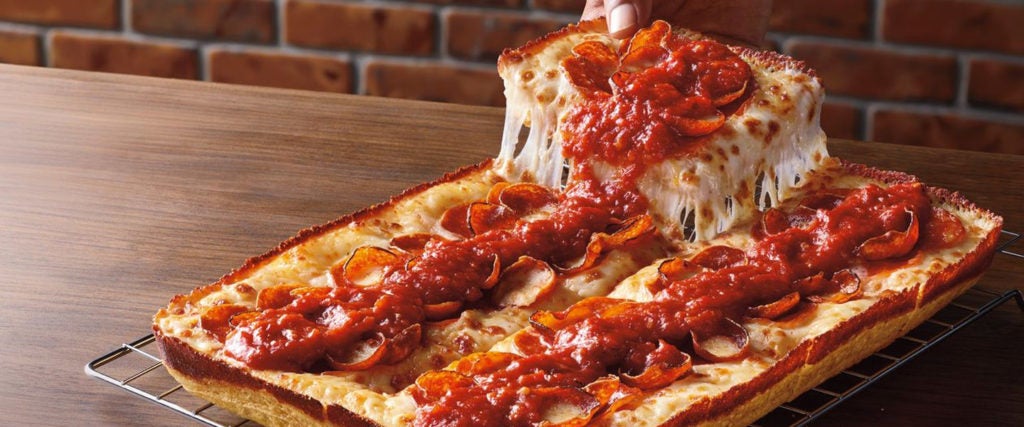You’d think I would have learned my lesson after the collective disaster that occurred when all of us here at MEL tried the Pizza Hut Triple Treat Box, but when the Hut announced that they were now serving Detroit-style pizza nationwide, I had to give it a shot. Because while trying this partially falls under my semi-official duties as MEL’s semi-official pizza correspondent, I’m also regularly on the lookout for ways to allow Pizza Hut to reclaim the childhood reverence I had for it.
Unfortunately, this new menu item didn’t quite cut it.
Excessive grease and instantaneous heartburn are par for the course when ordering from Pizza Hut, but the standard Detroit-style pepperoni pizza was so rich in different flavors it almost hurt my mouth. I love pepperoni, I also love extra pepperoni, but a layer of crispy pepperoni and a layer of softer pepperoni below it proved to be too much when coupled with the sauce and cheese and the ever-present grease. The worst part about it, though, is not that Pizza Hut has yet another mediocre menu item — the real tragedy is that much of America might think this is what Detroit-style pizza is all about, which would be a shame for a pizza with such a unique history.
Although Hawaiian pizza is only called that because some Canadian guy thought it seemed kind of Hawaiian, Detroit-style pizza is legitimately Detroit in just about every way, starting with what it’s cooked in. Despite the fact that deep dish pizzas cooked in cast iron pans were invented a few years earlier in Chicago, Detroit-style pizza was born in 1946 when restaurant owner Gus Guerra began pressing dough into blue steel pans used by automotive workers. The result was a pizza with an airy, golden, focaccia-like crust, which gave Detroit-style pizza its unique texture and look.

There’s a certain poetry to the fact that Motor City’s signature pizza is cooked in a drip tray, but that’s not the only thing that’s special about it. Nykolas Sulkiwskyj, owner of Loui’s Pizza in suburban Detroit, tells me that traditional Detroit-style has pepperoni pressed right into the dough, then cheese, then any additional toppings, then the sauce. The unique ordering of ingredients also contributes to a flavor difference, as the pepperoni flavor is infused into the dough.
How the cheese is handled is similarly unique. Not only is it put right up to the edges, resulting in a delicious, crispy burnt cheese border around the pizza, but they also specifically use “brick cheese” from the neighboring Midwestern state of Wisconsin. Unfamiliar with it, I ask Sulkiwskyj what he might compare it to, and he struggles to find an answer, saying, “It’s very much its own thing, but second only to the pan, that creamy, buttery cheese is what makes Detroit-style special.”

A pizza from Loui’s
Detroit-style pizza also has quite a story even beyond its origins, including the “Great Detroit Pizza War,” as the Detroit Free Press called it in the late 1970s. It all began at Buddy’s — that’s where Gus Guerra first pressed his dough into a drip pan — but after that, things got a little complicated. In 1953, Guerra separated from his partners at Buddy’s and began Cloverleaf Pizza, which has since become a chain in Michigan. Back at Buddy’s, the restaurant continued making the same kind of pizza that Guerra created, eventually coming to be owned by James Bonacorsi and James Valente, the latter of whom was the uncle of Nykolas Sulkiwskyj’s grandfather.
Sulkiwskyj tells me that eventually, Buddy’s was supposed to be passed to his grandfather, Louis Tourtois, who spent years as the head chef there, but that didn’t happen and Buddy’s was sold to someone else. His grandfather eventually decided to leave, moving over to a bar named Shield’s where he started making “Shield’s Pizza” out of the kitchen. Once again though, Shield’s got sold out from under him and became yet another local chain along with Cloverleaf. Eventually, Buddy’s became a chain as well.
Tourtois was something of a local celebrity in Detroit thanks to his renowned pizzas, so when he left Buddy’s for Shield’s, that began the Detroit Pizza Wars, which escalated when Tourtois founded Loui’s Pizza in 1978, where he continued with the same recipe for decades to come. “My grandpa loved the restaurant, he poured everything into it and was always concerned about its success,” Sulkiwskyj shares. “He died about six years ago and then Loui’s was passed onto me, where I’ve worked since I was 14. I’m 26 now, and he put 40 years into this place, so I figure that I can put in 40 years too.”
So there’s Buddy’s, Cloverleaf, Shield’s and Loui’s, which were — and indeed, still are — the four original big names in Detroit-style Pizza, and though many others exist nowadays, one other place is worthy of noting: The Detroit Style Pizza Company, founded by Shawn Randazzo, a local guy who started in the Detroit pizza scene delivering for Cloverleaf. Later on, he and his mother owned a Cloverleaf franchise. In 2012, Randazzo won the International Pizza Expo in Las Vegas with a Detroit-style pie, which exploded the national profile of Detroit-style pizza.
Suddenly, Detroit-style pizzerias — some authentic, some not — began popping up across the country as Randazzo began training chefs on how to make it. In 2013, Little Caesars put it on their menu, and as previously mentioned, Pizza Hut recently followed suit. Tragically, Randazzo died from brain cancer last year at the age of 44. “He was a really nice guy, I knew him, and he really helped to put Detroit-style pizza on the map,” Sulkiwskyj says.
Despite Randazzo’s passing, along with Tourtois and Guerra, guys like Sulkiwskyj are carrying on the proud tradition of Detroit-style pizza. And while it’s available all over the country now, with the biggest pizza chains latching onto the trend, Sulkiwskyj insists, “You’ve really got to go to Detroit — or at least Michigan — to get the real thing.”
And although that’s nearly 10 hours from where I am in New York, that still sounds more appetizing to me than another violent case of heartburn from Pizza Hut’s new Detroit-style pizza.

